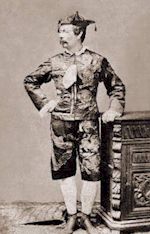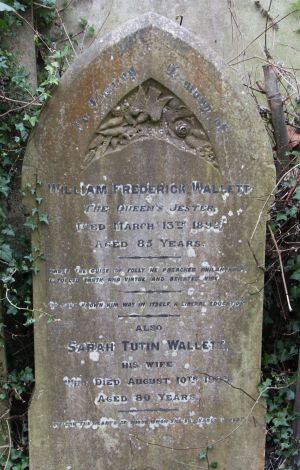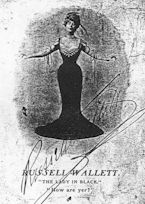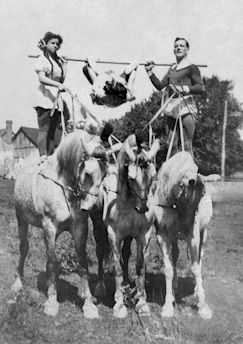| Home Topics Memorials Miscellany Transcripts References Family History Glossary Latest Beeston Blog About us | Site Search |
|
They Had Beeston Connections -Almost every place can name its famous son and daughters and Beeston is no exception - and they cover a very wide field of human endeavour. Some whose story we have to tell may be known to you already but others, although known beyond Beeston in their day, have largely been forgotten - more famous in their time perhaps but none-the-less, well worth recalling for their contribution to history. Several of those included here were not actually born in Beeston but all have a strong connection in one way or another. In some cases, they did not arrive in Beeston until they retired - but, nevertheless, Beeston claims them as "theirs". Our first notable was certainly one who arrived only after he had found fame elsewhere - William Wallett -
His undoubted talents as a performer were accompanied by a well-tuned talent for self-publicity. No opportunity was missed and when, on the 19th July 1844, he found himself appearing at Windsor Castle in front of Queen Victoria and the Prince Consort with the great Duke of Wellington in attendance, as part of the Van Amburgh company, he was received kindly by them and afterwards styled himself "The Queen's Jester" - of course, with no official royal authority. This was the masterstroke that made him a household name throughout the Midlands and the North in particular, fascinated audiences throughout the world and ensured that his place in the history of popular entertainment has not been forgotten. William Frederick Wallett was born in Hull about 1813 - dates vary in the range of records available to us and the date is often quoted as earlier, but his baptism at St Mary's, Lowgate in Hull on 28 July 1813 and his parent's marriage there on 23 January in the previous year certainly provide compelling evidence for that year. He was the oldest child of John and Margaret (nee Giles) who went on to have a family of five boys and two girls. It is believed that John Wallett was a mariner - although the 1861 census lists him as a "retired tailor" - and both he and his wife lived into their eighties, clearly proud of the fame that his name had brought to her family. In 1871, then a widow, Margaret listed herself on the census as "Queen Victoria's jester's mother" and happily "supported by her son". Each of the four of the sons who survived infancy went on to make the stage or circus their chosen career - although some were forced to fall back on less precarious occupations at times - and many of the subsequent generations followed the same route - some, as we shall see, finding considerable success and lasting fame. Like many who have started out in a career in entertainment, William had to be prepared to be flexible - even painting scenery in the early days and moving from small parts to the more substantial in the legitimate theatre before finally finding a niche as a circus clown as well as popular performances in the musical halls and light theatres - his act which featured his artistic representations of classical statues being particularly popular. This flexibility and feel for the popular was to take him into many parts of the world and kept him in demand for over sixty years and well into his time at Beeston - where the various occupations given to the census takers reflect the diversity of his career - comedian (1871), Professor of elocution (1881) and actor and lecturer (1891). In the true "the show must go on" tradition, he kept active virtually to the end using his Beeston home as a base. He is said to have he kept two kinds of posters in his cellar - "Wallett is Coming" and "Wallett is Here". When on tour he would wire for supplies of posters - such was his fame that these simple words were all it took to find an audience. This phase of Wallett's life is described in a fictional account based on fact, in 'Evenings of Wonder' by Sue King (ISBN 978-1-9161121-0-0). The author uses her research of 19th century circus entertainment to describe performances by them in the Isle of Man in that era. Wallett's appearances during a visit there in 1871 are well described. William married twice, his first wife being Mary Orme, the daughter of a Hull publican who he married in Lincoln in 1839 - although, it seems, not entirely with her father's blessing: Nottingham Review, on 26 April 1839, quoting Lincoln Gazette : "Shortly after the completion of the ceremony, the happy pair experienced an unwelcome interview with the father of the bride, accompanied by a constable, whose object was to take home, by physical force, the lady, who had left her father's house without his consent. The parties have since become reconciled."There were no surviving children from this marriage - although it is known that at least two were born to the couple who were not to survive infancy. The marriage could not have been an easy one, with Wallett frequently on tour, but nevertheless the couple were together for some 22 years before Mary's early death at the age of 40 in June 1861. Around that time, William was appearing as an equestrian act which had kept him away - some accounts say he was touring in America - when he was probably most needed, Certainly, he was alone in lodgings in Manchester only a couple of months previously at the time of the census in April. William Wallett's many visits to Nottingham in his early career often found him appearing at the music halls and glee clubs that offered popular entertainment in that town in the Victorian era. The Farmer family dominated musical entertainment at virtually every level in Nottingham for well over 100 years - and this included the provision of popular entertainment with Wallett a key ingredient. John Farmer had risen from a lowly background to become a major publican on Market Street in the centre of town. He and his three sons used this as a base for the development of a powerful network of business and social contacts - one son, William kept the Clarendon Hotel, another son John was an important milliner on Long Row and Henry dominated the music business in the town. And, as well, careful marriages by John's daughters added still further to the family's influence. One daughter, Sarah Tutin Farmer, remained unmarried however and it was she, in March 1862 - less than one year after the death of his first wife - whom Wallett married. However much, Farmer admired Wallett as an entertainer, it is unlikely that he would have seen him as a suitable husband for his daughter. What's more, since his wife died in 1843, John had probably looked to one daughter at least to stay unmarried. One way or the other, the location of their marriage - his hometown of Hull - certainly appears to confirm a lack of approval from her father.
During his time in Beeston he found time to write two accounts of aspects of his life in his own colourful style:
There remains some dispute - or, at least, confusion - as to the location of Wallett's house in Beeston. While we have found many who are prepared to confirm our belief that he lived at the substantial detached villa with gable windows that survives on Station Road on the corner and north of Grove Street, there are others who believe his home to be more on the corner of what is now Station and Queens Road on the site of the present-day convenience store. We believe that there is a simple explanation that embraces both - his first home in Beeston was on the latter site and the surviving house on the corner of Grove Street was one built by him and where he lived at the end of his life. (see Nottingham Weekly Guardian for Oct 14th 1922, "Local Notes and Queries") It was indicative of the esteem that he was held locally that, in the 1920s a newly laid-out road on the Beeston Fields Estate was named 'Wallett Avenue' in his honour. Then, in 2013, a Blue Plaque was unveiled on his home on Station Road (read more here ). These two local reminders serve as reminders of this amazing individual who embraced Beeston as his home. If modern-day Beestonians are often puzzled when Wallett's name is recalled and wonder about his place in history, there is certainly no doubt about his historical significance as a theatrical and circus pioneer from the many of his descendants and those having a connection with the many circus giants from the past who know of his reputation and honour and respect his contibutions in these fields during his varied and pioneering life. Individuals frequently make contact and sometimes - as happened in 2019 - make the pilrimage to Beeston. The story of one such visitor may be seen here . Children - There were two children by this second marriage - a boy Russell and a girl, Florence : Florence Margaret Wallett, born in 1869,married Marcus Astle of Wilne, Derbyshire, a cotton doubler, farmer and lace manufacturer with interests in Stapleford, and they had two daughters.
In 1894 he married Sarah Edith Helen Mansbridge - known in the family as Nellie - who was also on the stage and they toured together. Tragically, Russell died in 1912 at the early age of 45 of tuberculosis. Apparently he kept going almost to the end and had a couch to lie on in the wings between his acts.
Henry John Wallett (born Hull, 1830) was an actor on the British stage - certainly at various times in the period 1861 to 1881 although, in 1871 he is to be found working as a mason's labourer when, presumably, work on the stage was not available. Clifford Wallett (born Hull, 1834) worked as a clown during his short life that was terminated prematurely by tuberculosis in 1855 at the age of 21. Can You Help - Tracking the history of members of any family who made their living on the stage is often difficult. Many of the family members move constantly from one temporary address to another, sometimes it appears that they are missed by enumerators and even appear to neglect the registration of key events - or, at the very least, the registrations are difficult to identify with certainty. Coupled with these difficulties, is the tendency to paint a flamboyant picture which pushes the facts to the limit! The Wallett family are certainly no exception - with the added complication of their travel to other countries and various times in their lives. As a result, there are still gaps and, no doubt, some inaccuracies, in this account and the accompanying genealogy. Any comments, additions or corrections would certainly be most welcome.
There are still a few mysteries!
© David Hallam - 2005-2020 - david@beeston-notts.co.uk Click here to go back to the beginning |
|
|||||||||||||||||
|
|
|||||||||||||||||||

 The influence of Sarah and her family was probably a major factor which led to William Wallett's decision, taken
soon after this marriage, to put down more permanent roots in Beeston, then fast becoming a fashionable suburb for
those wanting to escape over-crowded Nottingham. That is not to say that he gave up touring, for example, in December
1865 he was appearing at the New American Theatre in Philadelphia - billed, as ever, as "W F Wallett the Queen's
Jester". Whatever the doubts and whatever the unusual demands of his occupation, the partnership worked well. As
is so often the case with those who depend for their livelihood in this field, the family fortunes varied enormously.
When he had money he lived in style with a carriage and pair while at other times his wife had the greatest difficulty
in managing the household budget - although, in good times and in bad, they are said to have remained very happy
together. In personal life he was noted as the best raconteur in Nottingham and many people in Beeston sought his
company in old age to enjoy his wit and charm. As well as being an amusing man he was very compassionate and did
much for the poor. In politics, he was a staunch Liberal and a great admirer of Gladstone and later in her life his
daughter remembered his reading Gladstone's speeches to the family. He died of pneumonia following a bout of influenza,
at his home in Beeston on 13th March 1892 and was buried at the General Cemetery in Nottingham where his memorial survives
(Shown Right). Although, from the available evidence, his age at his death appears to have been 78 or 79, both his
memorial stone inscription and contemporary obituaries appear to overstate his age at 85 years.
The influence of Sarah and her family was probably a major factor which led to William Wallett's decision, taken
soon after this marriage, to put down more permanent roots in Beeston, then fast becoming a fashionable suburb for
those wanting to escape over-crowded Nottingham. That is not to say that he gave up touring, for example, in December
1865 he was appearing at the New American Theatre in Philadelphia - billed, as ever, as "W F Wallett the Queen's
Jester". Whatever the doubts and whatever the unusual demands of his occupation, the partnership worked well. As
is so often the case with those who depend for their livelihood in this field, the family fortunes varied enormously.
When he had money he lived in style with a carriage and pair while at other times his wife had the greatest difficulty
in managing the household budget - although, in good times and in bad, they are said to have remained very happy
together. In personal life he was noted as the best raconteur in Nottingham and many people in Beeston sought his
company in old age to enjoy his wit and charm. As well as being an amusing man he was very compassionate and did
much for the poor. In politics, he was a staunch Liberal and a great admirer of Gladstone and later in her life his
daughter remembered his reading Gladstone's speeches to the family. He died of pneumonia following a bout of influenza,
at his home in Beeston on 13th March 1892 and was buried at the General Cemetery in Nottingham where his memorial survives
(Shown Right). Although, from the available evidence, his age at his death appears to have been 78 or 79, both his
memorial stone inscription and contemporary obituaries appear to overstate his age at 85 years. Russell Gladstone
Wallett, born in 1867, was articled to the law, and admitted a solicitor in October
1890 and immediately opened a practice on his own account in Nottingham. The stage, however, had a strong attraction
for him, and, when, in July 1893, and after local amateur performances, he received an offer to go on tour as an
understudy in Don Quixote, he took up the offer immediately. In a move that was reminiscent of the great George
Grossmith, he had abandoned the law for the uncertainties of the stage. But, happily, success followed this initial
leap of faith; there was an early engagement with Wombwell's travelling pantomime touring the northern towns, followed
by regular work appearing in a stream of musical shows and pantomimes - in which he was to make a big reputation for
himself as an exceptionally clever dame, and for the realism of his female impersonations. In addition to the regular
English circuits, he appeared in Dublin and also toured South Africa. He was a man of many parts; before going on the
stage, he had been a prominent footballer and cyclist - he had played for both Notts County and Nottingham Forest and
won many trophies on the cycle. An expert banjoist, he was amateur champion in 1887.
Russell Gladstone
Wallett, born in 1867, was articled to the law, and admitted a solicitor in October
1890 and immediately opened a practice on his own account in Nottingham. The stage, however, had a strong attraction
for him, and, when, in July 1893, and after local amateur performances, he received an offer to go on tour as an
understudy in Don Quixote, he took up the offer immediately. In a move that was reminiscent of the great George
Grossmith, he had abandoned the law for the uncertainties of the stage. But, happily, success followed this initial
leap of faith; there was an early engagement with Wombwell's travelling pantomime touring the northern towns, followed
by regular work appearing in a stream of musical shows and pantomimes - in which he was to make a big reputation for
himself as an exceptionally clever dame, and for the realism of his female impersonations. In addition to the regular
English circuits, he appeared in Dublin and also toured South Africa. He was a man of many parts; before going on the
stage, he had been a prominent footballer and cyclist - he had played for both Notts County and Nottingham Forest and
won many trophies on the cycle. An expert banjoist, he was amateur champion in 1887.
